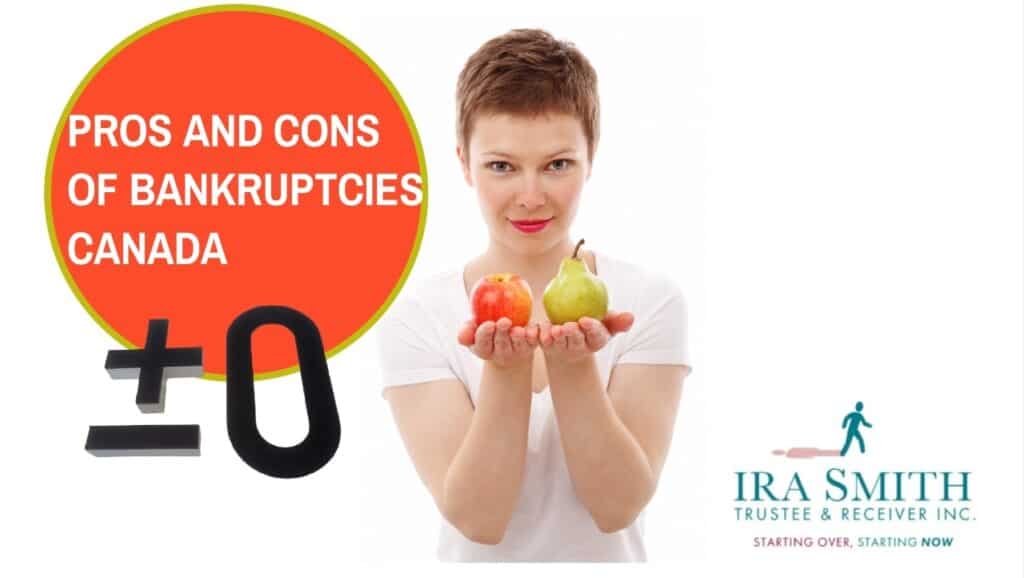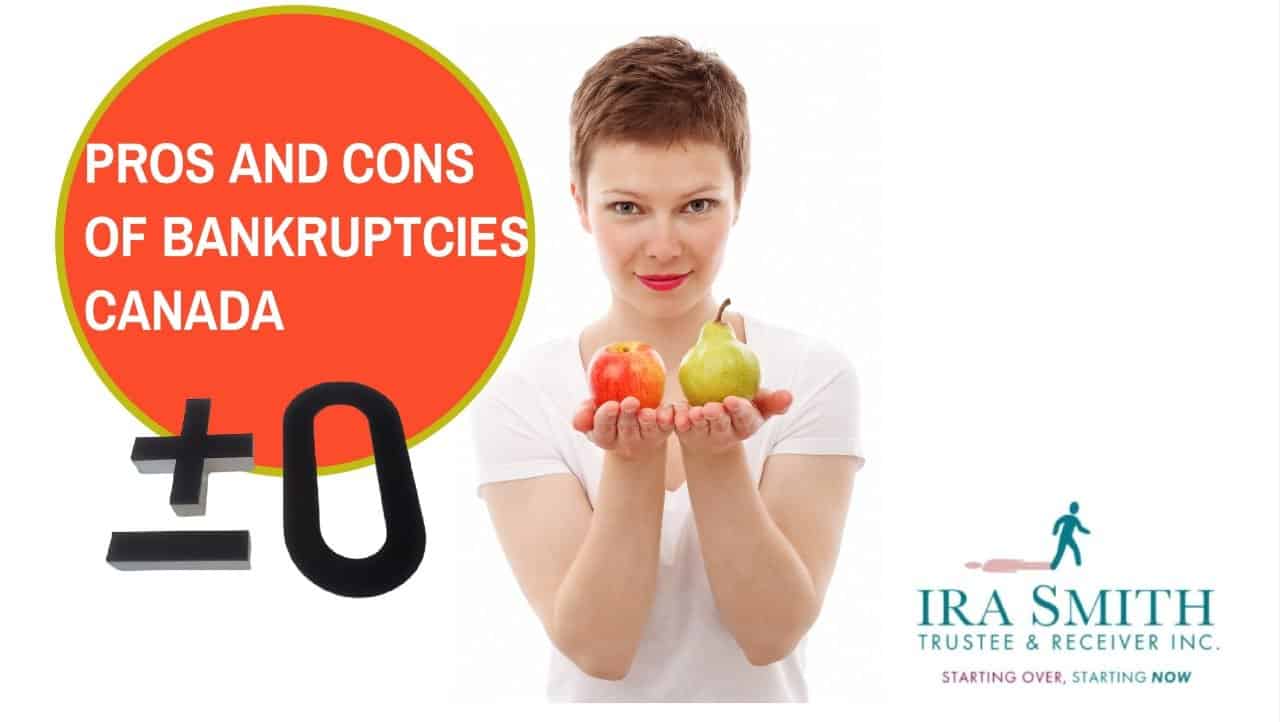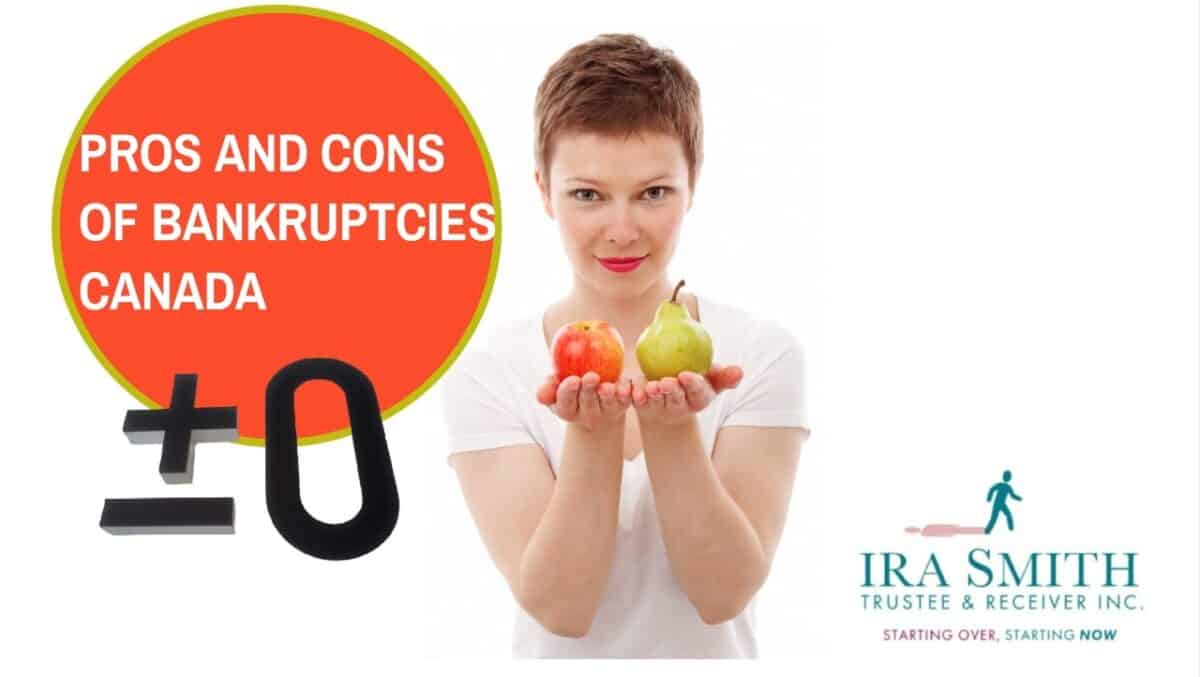Evaluating the pros and cons of bankruptcies Canada: Introduction
When you are in debt, it can feel like you are stuck in quicksand – the more you struggle, the deeper you sink. If you are considering bankruptcy, you are not alone. According to the Office of the Superintendent of Bankruptcy (OSB), almost 100,000 Canadians filed either a consumer proposal or for bankruptcy in 2021. The numbers for 2022 are rising above the 2021 level.
Before you make a decision, it is crucial to weigh the pros and cons of filing for bankruptcy in Canada. On the positive side, bankruptcy can give you a fresh start. It can discharge your debts and give you a chance to rebuild your finances. On the negative side, bankruptcy can damage your credit score more than one of the bankruptcy alternatives.
If you are struggling with debt, there are other options to consider before bankruptcy. You may be able to negotiate with your creditors and set up a payment plan. You can also improve your financial situation by cutting expenses and increasing your income. If you decide that you do need an insolvency process, a consumer proposal or a Division I Proposal may be better for you.
In this Brandon’s Blog post, I wish to aid you in gaining a better understanding of the pros and cons of bankruptcies Canada. Then you can make a much more educated choice about your financial debt issues.
What are the pros and cons of bankruptcies Canada?
When it comes to making the decision to file for bankruptcy, it is important to understand all of the implications that this will have on your life. In Canada, bankruptcy is a legal process that allows individuals to discharge all of their debts if they are unable to repay them. This process is overseen by the OSB, and there are certain requirements that must be met in order to be eligible for bankruptcy.
While bankruptcy can provide relief from debt, it is not without its drawbacks. Once you have been declared bankrupt, your credit rating will be significantly damaged, which can make it difficult to obtain new lines of credit in the future. Additionally, your assets may be seized in order to repay your creditors.
Before making the decision to file for bankruptcy, it is important to weigh the pros and cons carefully. Speak with a financial professional to get advice that is specific to your situation. Now for a more detailed discussion on the pros and cons of bankruptcies Canada.

The pros of bankruptcies Canada
A fresh start
If you’re sick of being in debt, bankruptcy might be a good option for you. It can be a fresh start, and it’ll get creditors off your back. You can move on with your life without all that stress.
Rebuild your credit
As stated above, bankruptcy will cause some damage to your credit. However, it can stop the continuous damage you may be facing now. You can begin rebuilding your credit rating, rather than having to face extra charges from missed payments as well as receiving those pesky telephone calls from bill collectors.
Get rid of most if not all of your debts
In most cases, all of your obligations will be cleared by your bankruptcy discharge. Normally cleared debts are your unsecured debts like credit card debt, lines of credit, personal loans, payday loans, and income tax debts. A bankruptcy filing will let you not worry about a ton of bills but will force you to focus on balancing your budget.
There are some obligations that bankruptcy cannot clear, like child or spousal support payments, or payments for fines or penalties awarded by a court. You can get your student loans discharged too as long as you’ve been out of school for 7 years or even more.
Stop debt collectors cold
Creditors and their debt collectors making their collection calls can be pretty aggressive when they’re trying to get paid. Bill collectors demand and try to scare you as to what will happen if you do not pay up. Answering your phone or checking your VM becomes terrifying. You might also have a ton of mail from them stacking up in your mailbox, inbox, and so on.
If you’re losing the battle of staying up to date with your bill payments, personal bankruptcy might be a good option for you. Declaring bankruptcy stops all collection efforts, including calls as well as letters from your creditors. This is called the “automatic stay of proceedings”. When you’ve filed an assignment in bankruptcy, the automatic stay goes on and offers you some breathing space.
Get rid of any wage garnishment
If you file for bankruptcy, you don’t need to worry about wage garnishment or legal action anymore. The stay of proceedings also prevents any further attempts at collection, including wage garnishment. Creditors and collectors also won’t be able to take you to court.
Bankruptcy is not forever
So, if you’re thinking about filing for the bankruptcy process, know that it usually takes about nine months to go through the process for a first-time bankrupt who does not have any surplus income payments to make to your Trustee. And, if the Licensed Insolvency Trustee handling your case finds that you have surplus income, you won’t be able to get a discharge for 21 months.
If this is your second bankruptcy, it will take longer. If you don’t have surplus income payments to make, it will take 24 months. If you do need to make surplus income payments, it will take 36 months.
These are the pros when considering the pros and cons of bankruptcies Canada. Now for the cons!

The cons of bankruptcy
There are many cons of filing bankruptcy, including:
Your credit rating
If you file for bankruptcy, it’ll rank you as an R9 on your credit report, which is pretty bad news for your credit score. The damages to your credit rating will not last forever. Your very first personal bankruptcy will be noted on your credit record for 6 years after the day of your bankruptcy discharge. A second bankruptcy will certainly harm your credit score for a lot longer.
At the outset of your bankruptcy journey, you cannot see the light at the end of the tunnel. At least you now have a roadmap to restoring your credit and have a date when your credit will be cleared of any damage. You can start to rebuild your credit even before you are discharged from bankruptcy.
Your assets may be liquidated
This doesn’t mean that you’ll lose everything. Your personal belongings – like clothes, household items, work tools, and even a car under a certain value – usually can’t be taken away from you in bankruptcy. This means that the proceeds from the sale of your other non-exempt assets will be used to repay your creditors.
RRSP contributions in the past 12 months are not exempt
Your retirement savings are protected, but any contributions you made in the past 12 months to your RRSP are not exempt.
Surplus income and the cost of bankruptcy
If you’re making more money than the surplus income threshold, you’ll also have to make surplus income payments to your Licensed Insolvency Trustee. If you don’t have any assets and don’t have to pay the surplus income requirement, you or a relative will have to pay your Trustee’s fee.
Complete financial disclosure
You will need to make full financial disclosure to your Trustee. Your Licensed Insolvency Trustee will use that information to help you complete a Statement of Affairs. This disclosure details your financial position and will even potentially highlight certain financial transactions. Essentially your Trustee and the court will know everything about your finances and your creditors will get a peek too.
When you’re going through bankruptcy, you’ll need to hand over your tax docs and pay stubs to show how much you’re earning. This is how the Trustee decides if you’ve gone over the surplus income threshold.
A lasting record
Once you file for bankruptcy, the paperwork will become part of the public record in Canada. To start your bankruptcy, your Licensed Insolvency Trustee files your bankruptcy documents with the OSB. It then becomes part of the public record.
Most people who file for bankruptcy will only have their Trustee, the OSB, the court, their creditors and the two Canadian credit bureaus know about it.

Bankruptcy alternatives from pros and cons of bankruptcies Canada
Now that you understand the pros and cons of Canadian bankruptcies, you must just consider this option as a last choice. If you can solve your financial problems without experiencing the unfavourable elements of personal bankruptcy, that is the most effective way to go.
During your initial no-cost consultation, the Licensed Insolvency Trustee will help you should explore all the bankruptcy alternatives. I have written before in more detail about each of the bankruptcy alternatives listed below. I have included a link to each of those more detailed blogs. The main alternatives to bankruptcy are:
Debt consolidation
If you’re aiming to leave financial debt behind, debt consolidation could be a good alternative for you. By rolling all your financial obligations into one financing with a lower rate of interest, you will save money from the lower rate of interest on the new consolidation loan and leave your debt behind much faster.
Just make sure that you understand the current interest rates you are being charged, the total of your monthly payments that you currently may or may not be able to afford, the interest rate being offered to you on a debt consolidation loan, what your new monthly payment will be and make sure that you have a realistic budget of your monthly income and monthly expenses that shows that you can afford the new payments on a monthly basis.
Credit counselling
Credit counselling is a process whereby a person in debt meets with a credit counsellor to discuss their options for dealing with their debt. The credit counsellor will assess the person’s financial situation and provide advice on how to best deal with the debt. This may include negotiating with creditors to reduce interest rates or monthly payments and setting up a debt management plan.
As I have written many times before, you should only go to a community-based non-profit credit counselling agency that does not charge any fees. If the credit counsellor you choose wants to charge you fees, get out of there. It is not the best choice for you.
Debt settlement
Debt settlement is a process in which you can negotiate with your creditors to pay less than the full amount you owe. This can be a good option if you are not able to pay your debts in full and you are willing to negotiate with your creditors.
Debt settlement works well if you only have 1 or a few creditors. If you have many creditors, debt settlement is much more difficult in making sure that everyone remains on board with the negotiated settlement and that you will have enough money to pay the lower settled amounts you promised.
Many times with a multitude of creditors, either a consumer proposal or a Division I Proposal is the most effective way to bind everyone in a debt settlement process.
Like in credit counselling, I urge you to stay away from debt settlement companies that charge fees. What they do is charge you unnecessary fees, try to sell you products you don’t need and then when they cannot sell you any more products and their debt settlement techniques do not work, they then walk you to their favourite Licensed Insolvency Trustee for an insolvency process, which might just be a bankruptcy.
I would rather see you use your accountant or lawyer if you do not feel comfortable negotiating yourself. Those professionals will have your best interests at heart in return for their fee. They also won’t try to sell you more products.
Consumer proposals
When it comes to debt of $250,000 or less (other than for secured debts registered against your home), there are a number of options available to help you get back on track. One option is a consumer proposal.
A consumer proposal is a formal debt relief and debt-settlement option available in Canada. It is a legally binding agreement between you and your creditors. Under a consumer proposal, you agree to repay a portion of your debts, and your creditors agree to forgive the rest.
A consumer proposal can be an attractive option for many reasons. First, it can help you get out of debt without having to declare bankruptcy. Second, it can help you keep your assets, such as your home or car. Third, it can give you a fresh start by wiping away most, if not all, of your unsecured debts.
If you’re considering a consumer proposal, it is necessary to obtain assistance from a qualified expert. A Licensed Insolvency Trustee, who is also a consumer proposal administrator in Canada, can walk you through the process and answer your questions. This will allow you to see if it’s the right choice for you.
Division I Proposal
If you owe more than $250,000, a Division I Proposal is a great option to settle your debts. It’s not as streamlined as a consumer proposal, but it’s still a great way to get out of debt.
Other than these technical differences, it has the same aim as a consumer proposal: to provide a debt settlement option that will bind all unsecured creditors and get the person back onto their feet free of the stress and burden of their unmanageable debts.
Either a consumer proposal or a Division I Proposal are excellent debt relief options approved by the Canadian government. One of the other benefits of either of these two debt settlement options is that the person will also receive two mandatory financial counselling sessions. Getting this education will help put the person on the right track for the rest of their life.
Understanding the advantages of bankruptcy and also the disadvantages of bankruptcy for companies
When a company faces overwhelming debt, bankruptcy may seem like the only way out. However, there is only one advantage and one disadvantage to bankruptcy for a company.
One advantage of this situation is that the Trustee may be able to sell the assets to a purchaser who will then be able to use those assets to continue the former business of the company in a profitable way. This could potentially save some jobs, at least for the key employees of the old business.
The one disadvantage is that unlike a person, when a company goes bankrupt, the corporate legal entity is now dead.
Before the Directors of a company decide to bankrupt the company, they should determine if certain divisions or parts of the business can be saved and operate profitably if the unprofitable part(s) could be eliminated. If so, a financial restructuring can be done to turn this unprofitable company into a viable and profitable one and save some jobs in the process.

Pros and cons of bankruptcies Canada: Summary
I hope you enjoyed this Brandon’s Blog on the pros and cons of bankruptcies Canada.
People are falling behind with stagnant wages or tiny wage increases while there is runaway inflation and they are falling deeper and deeper into debt. Revenue and cash flow shortages are critical issues facing entrepreneurs and their companies and businesses. Are you now worried about just how you or your business are going to survive? Those concerns are obviously on your mind. Coming out of the pandemic, we are now worried about its economic effects of inflation and a potential recession.
The Ira Smith Team understands these concerns. More significantly, we know the requirements of the business owner or the individual that has way too much financial debt. You are trying to manage these difficult financial problems and you are understandably anxious.
It is not your fault you can’t fix this problem on your own. The pandemic has thrown everyone a curveball. We have not been trained to deal with this. You have only been taught the old ways. The old ways do not work anymore. The Ira Smith Team makes use of new contemporary ways to get you out of your debt problems while avoiding bankruptcy. We can get you debt relief now, while explaining the pros and cons of bankruptcies Canada or any other of our recommendations.
We look at your whole circumstance and design a strategy that is as distinct as you are. We take the load off of your shoulders as part of the debt settlement strategy we will draft just for you. There are many pros and cons of bankruptcies Canada. Whatever process we recommend for you will, we will do so in order to minimize any cons you may experience.
We understand that people facing money problems require a lifeline. That is why we can establish a restructuring procedure for you and end the discomfort you feel.
Call us now for a no-cost consultation. We will listen to the unique issues facing you and provide you with practical and actionable ideas you can implement right away to end the pain points in your financial life, Starting Over, Starting Now.


